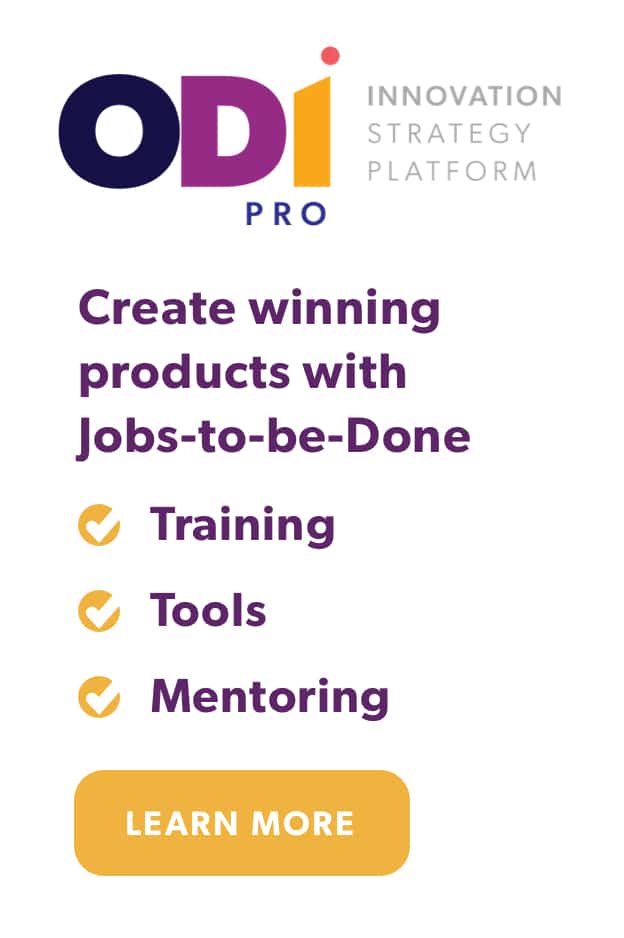By: Eric Eskey
Defining the customer’s job-to-be-done correctly is fundamental to a company’s success. Don’t let these two common mistakes derail your innovation efforts.
All companies acquire culture, with or without trying. Some cultures become more innovative than others. How do they accomplish this feat?
In this post, I explain how companies cultivate innovation by contending with two culture algorithms: one governing individual behavior and the other, group behavior. I provide advice on specific actions you can take individually to grow your innovation culture—and if you’re also a leader, further steps to nudge your organization closer to winning your future.
Culture begins with you and an idea.
The solid foundation for a science of innovation is our biology. Through this lens, we can see an idea for what it is—a network in our brains. When a new idea comes to mind, it does so because a specific constellation of neurons fires with each other for the first time. Whether your idea is a new way to solve a complex business problem, a tagline in a marketing campaign, or a software application feature, ideas are physical networks of thousands of co-firing neurons. [efn_note]Johnson, Steven. Where Good Ideas Come From (pp. 45-46). Penguin Publishing Group. Kindle Edition.[/efn_note]
Mind-boggling, right? Although we do not know precisely how creativity works, we do know that it is an evolutionary process within the brain. It depends on neurons exploring the adjacent connections they can make with other neurons. Through trial and error, we consciously and subconsciously explore variations of an idea, discover its merits and faults, discard unworkable ideas, and nurture the most successful. This process is possible—and only possible—because a specific network of neurons connects with new neurons or adopts a new configuration. [efn_note]Deutsch, David. The Beginning of Infinity: Explanations That Transform the World (p. 373). Penguin Publishing Group. Kindle Edition.[/efn_note]
The “idea” of an idea as a network makes several imperatives clear. A network must be both dense and dynamic to produce innovation. We can’t have an epiphany with only a few neurons firing. And even if a network is dense, it must also be changing; a static network is incapable of exploring new possibilities and improving upon existing ideas.
How, then, can we become more innovative individuals? We can push our brains to form more creative networks by placing ourselves in environments that mimic our neural signature—connecting with diverse people and ideas and experimenting with the ideas that emerge. [efn_note]This approach is sometimes called memetics – the study of ideas and culture based on their evolution.[/efn_note]
Step 1: Increase the density, diversity, and dynamism of your innovation network.
First ask, “How extensive is your network?” If your network is small, expand it. For instance, consider attending a virtual cocktail party. And once social distancing passes, commit to never eating alone.
Next ask, “How diverse is your network?” Consider how many people you connect with weekly with different backgrounds and perspectives from yours: teenagers and senior citizens; people who were born in or come from other countries or socioeconomic backgrounds; those with different political leanings from your own; and colleagues from different divisions, professions, and industries.
If your network consists of similar people, make it a priority to identify and get into conversation with people who are different from you. Reach across the aisle. Do it weekly, if not daily, and guarantee that it happens by scheduling it in your calendar—now.
How many conferences do you attend each year? Once they’re back up and running again, attend at least two. When you’re there, make an effort to meet new people and get to know what problems and issues they’re facing. Ask for their ideas and perspectives on the problems you face. If it’s not feasible to attend conferences in person, do so virtually, and set aside time to watch one TED Talk daily. And this is important—engage in the conversation in the comments.
Join an innovation community, and if one doesn’t exist that’s right for you, create one. Meet at least monthly to discuss trends and new ideas. And make sure its membership is diverse and includes members that don’t think like you.
Consider cross-training with experts. Let’s say you’re a Design Thinker and applying another innovation methodology is anathema. Take a course in a competing innovation methodology anyway. You may be surprised by the ideas that emerge.
[efn_note]Christensen, Clayton M. The Innovator’s DNA: Mastering the Five Skills of Disruptive Innovators. Harvard Business Review Press. Kindle Edition.[/efn_note]
Step 2: Provide a mechanism for people to easily remember ideas.
Culture evolves as ideas spread to others.
While it is true that ideas happen inside minds, no mind is an island. Our connections with others give flight to ideas. Gossip, internet memes, and well-posed ideas can spread like wildfire. How do ideas like these come to flourish?
There are three characteristics of ideas that thrive. These ideas:
- Grab and hold our attention;
- Are easy to remember;
- Compel us to act.
The others die. [efn_note]Heath, Chip. Made to Stick: Why Some Ideas Survive and Others Die. Random House Publishing Group. Kindle Edition.[/efn_note]Consider the last idea you encountered. Did you act on it? If so, you transmuted the idea from the world of neurons into physical behavior. Writing an idea down, expanding on it, or presenting it to others gives it life. Liking a post, sharing it, or—even better—commenting on it, amplifies the idea and nudges it to evolve into something more spread-worthy. Your conspicuous purchases advertises desires, beliefs, and ideas to others. So, too, does working to break free from a bad habit and replacing it with a good one. It is action—and only action—that allows sparks to leap from one innovator and ignite another.
Your action gives the idea the potential to be seen, understood, and imitated. If the idea then grabs and holds someone else’s attention, it has another chance to be understood, remembered, and—if useful to the holder—acted upon again.
Ideas that survive take hold, are retold, and over subsequent rounds of retelling, the most spread-worthy ideas will spread widely and eventually take over the culture. As different minds tinker with the idea differently, the idea will cumulatively evolve to become more effective at spreading.[efn_note]Heath, Chip. Made to Stick: Why Some Ideas Survive and Others Die. Random House Publishing Group. Kindle Edition.[/efn_note]
Finally, we must remember our ideas. It is in our nature not only to forget but to be overconfident that we’ll not forget. Hence, if you don’t already have a journaling practice, write *everything* down in a book, journal, or if you must, with post-it notes.
Taking these actions will increase the odds that *you* will have a spark, flash, lightbulb moment, breakthrough, or epiphany. And cultivating an innovation culture begins with *you.*
Now, are these actions sufficient to ignite a culture of innovation?
Whether neonatal ideas survive or not depends upon another challenge—how well you can nurture them to be spreadable to others.
Just as an idea is a network in a brain, culture is a network of ideas that link brains—a set of shared ideas that cause their holders to act alike in some ways. [efn_note]Deutsch, David. The Beginning of Infinity: Explanations That Transform the World (p. 396). Penguin Publishing Group. Kindle Edition.[/efn_note]Therein lies the challenge in stoking a culture of innovation. It’s not enough to have a fully formed idea in your mind of how the world could be and a way to make it so. It’s necessary to translate the web of ideas in your mind into a string of action that is worthy of the attention of others, causes them to seek to grasp the idea, and motivates them to act, thereby transmitting the idea to others.Action is necessary because we cannot download each other’s knowledge like an app. Without action, an idea lies inert in a siloed mind. With action, an idea becomes noticeable. It can vie for the attention of others, win their acceptance, and affect their behavior. And activities that cause an idea to spread do not need to be an explicit retelling of the idea in writing or presentation. As long as it can be observed and imitated, it can spread.
Step 3: Increase the density, diversity, and dynamism of connections *between* people in your organization.
How, then, can we organizationally become more innovative?
Recognize there’s a direct connection between our biology and culture. We’re not blank slates. We can only use the tools we’ve inherited. Instead of obsessing over innovation theater—such as idea challenges, hackathons, bean bags, and smoothie machines—play with the significant forces that have shaped us over eons.
If we wish to nurture an innovation culture, we must cultivate an innovation network. This approach is sometimes called mimetics, which calls on us to follow biology as a teacher in fostering change. Start by supporting your people with the tools that help them form denser, more diverse, and more dynamic networks.
Foster internal meetups. If you can afford it, pay for their attendance at conferences. Open your all-hands meetings with an external speaker. If that’s unreasonable, play a TED talk.
Pay to train your people in a variety of innovation methodologies. If that is unaffordable, buy them books monthly and incentivize them to study them, such as with 30-minutes of daily paid leave to read.
Give them a place to record and remember their ideas. You could undoubtedly implement a heavyweight innovation management tool. There are effective lightweight solutions, too. Moo, for example, offers high-quality journals suitable for this purpose. At the start of meetings, give each team member a standup-minute to share one new idea. For the most promising idea in a given round, set a clock for ten minutes and allow the team to discuss it. You might be surprised by how quickly innovation begins to increase.
Next, engineer the structure of your innovation network to optimize the flow of useful information. Planning this system requires balance. At one end of the spectrum, a network with no connections and no information flow is like ice—a solid frozen in time. At the other extreme, everyone is connected with everyone else, inundating them with information and ideas. There are numerous collisions—as we see in any gas—but ideas form and dissolve quickly like wisps of clouds. No one retains information.
The best network will find a middle ground. Rather than connect everyone, get the right people connected. Identify who is responsible for making sure the *right* products and services will enter the development process. Your guiding team will likely include a mix of developers, engineers, scientists, marketers, and front-line leaders.
Then ensure they have the information they need to conceptualize winning solutions (i.e., products and services that get the customer’s “job” done better or more cheaply). They must also be able to assess, with a high degree of certainty, which proposed solutions will get the “job” done best and win in the marketplace. They must have a fail-safe method in place for deciding where to invest. In my experience, companies spend far more marketing inferior products to their customers than they spend gathering and prioritizing their customers’ needs. They further forgo opportunities when they fail to disseminate those insights far and wide in their innovation networks—where other innovators can make the best use of that information.
Don’t be that company.
Step 4: Align your teams by giving them a north-star—a strategic intent based on the core jobs your customers are trying to get done.
You also need to give your innovation teams a destination postcard—a strategic intent—that paints a picture of a future worth creating. Here are a few examples of strategic purposes that are job-focused, capture the essence of winning, and set targets that deserve personal effort and commitment:
- “Land a man on the moon ahead of the Soviets.”
- “We want to put 1000s of songs in your pocket.”
- “Save endangered species from extinction.”
(As an aside, Strategyn’s purpose is to enrich lives by bringing predictability to the often-random process of innovation. We’ve thus set our strategic intent as, “Help 30 companies secure a market leadership position in the next three years.”)
What future can you create that inspires you and calls your people to bring forward their best ideas and thinking?
Creating strategic intent is especially helpful when facing tribalism – behaviors and attitudes that stem from strong loyalties to particular social groups, which tend to slow innovation. Tribalism results in different groups pursuing different goals or pursuing the same goals with different beliefs. This misalignment is like many sabretooth tigers, each pursuing different wooly mammoths. Both are now extinct. By appealing to a shared identity, a shared ideal, and shared destination, setting a strategic intent aligns those who get it and want it to work together, as a pride of lions, on the hunt to create a desired future.

Step 5: Live by values that increase the odds that the best ideas emerge and are allowed to spread.
Finally, consider your values. In innovation cultures that flourish, while everyone desires to be right, they collectively want to know the truth. They thereby live by values such as:
- Everyone must acknowledge that not everyone can be right about everything.
- Everyone must give airtime to conflicting views.
- You have to provide reasons for your beliefs.
- You’re allowed to point out flaws in the opinions, ideas, or thoughts of others.
- You’re not allowed to forcibly shut people down who disagree with you.
Consider the extreme case in which the opposite of these values is present—it’s the very definition of a static, unchanging culture. Don’t attempt to engineer a culture that is, whether by design or accident, in opposition to these values. It’s a losing proposition.
Culture can be shaped to cause ideas to flourish.
What is a good innovation culture? We can judge the goodness of a culture by its fitness for the organization’s purpose or intent. Ask, “How well does our culture help our people and our customers to get their jobs done?”
Mostly, culture comes to be by accident. Are we taking our good and bad innovation fortune for granted? What if we can actively shape it instead?
I propose that we *can* shape our innovation culture. Let’s carry forward our list of imperatives:
- As individuals, increase the density, diversity, and dynamism of our own networks of connections with people and ideas.
- Provide a mechanism for people to easily remember ideas (and find them when forgotten).
- As leaders, increase the density, diversity, and dynamism of connections *between* people in our organizations.
- Align our teams by giving them a north-star—a strategic intent based on the core jobs your customers are trying to get done.
- Live by values that increase the odds that the best ideas emerge and are allowed to spread.
Culture embodies the lessons of our inheritance—both its gifts and burdens. It’s part of what explains our past success. What predicts our future success? Your contribution and our collective ability to help ideas to flourish.
- Johnson, Steven. Where Good Ideas Come From (pp. 45-46). Penguin Publishing Group. Kindle Edition.
- Deutsch, David. The Beginning of Infinity: Explanations That Transform the World (p. 373). Penguin Publishing Group. Kindle Edition.
- This approach is sometimes called memetics – the study of ideas and culture based on their evolution.
- Christensen, Clayton M. The Innovator’s DNA: Mastering the Five Skills of Disruptive Innovators. Harvard Business Review Press. Kindle Edition.
- Heath, Chip. Made to Stick: Why Some Ideas Survive and Others Die. Random House Publishing Group. Kindle Edition.
- Pinker, Steven. How the Mind Works (pp. 208-209). W. W. Norton & Company. Kindle Edition.
- Deutsch, David. The Beginning of Infinity: Explanations That Transform the World (p. 396). Penguin Publishing Group. Kindle Edition.





